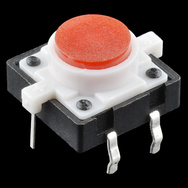BBC micro:bit
Bit:Commander Simon Game
Introduction
This is the first non-controller idea that I had for the Bit:Commander. It has the lights, the buzzer and the 4 different coloured buttons that you need.

The first time I tried this, I had the LEDs brighter than they are. When I gave it to Chris to try out in a lesson, I saw how brightly it lit up his whole head and how much he rubbed his eyes when he'd finished playing. I've probably left it a little too bright still. Tweak the numbers for the colours down a little until you are comfortable using this for a game.
from microbit import *
import music
import random
import neopixel
# red, blue, green, yellow
button_pins = [pin12, pin15, pin14, pin16]
# Initialise neopixels
npix = neopixel.NeoPixel(pin13, 6)
red = (64,0,0)
green = (0,64,0)
blue = (0,0,64)
yellow = (64,24,0)
off = (0,0,0)
ledcols = [red,blue,green,yellow]
# matrix helper
d = [Image.ARROW_N,Image.ARROW_E,Image.ARROW_S,Image.ARROW_W]
notes = [659, 880, 330, 554]
def LightAll(col):
for pix in range(0, len(npix)):
npix[pix] = col
npix.show()
def GetRandomSequence():
return [int(4*random.random()) for i in range(0,100)]
def PlaySequence(t, s):
for i in range(0,t):
LightAll(ledcols[s[i]])
display.show(d[s[i]])
music.pitch(notes[s[i]],500)
display.clear()
LightAll(off)
sleep(200)
def Win():
for i in range(0,4):
for j in range(0,4):
LightAll(ledcols[j])
music.pitch(notes[j],50)
LightAll(off)
sleep(1000)
def Loss():
music.pitch(131,500)
sleep(1500)
def PlayGame():
turn = 0
sequence = GetRandomSequence()
userSequence = [0]*100
seqlen = 0
playing = True
played = False
while playing==True:
if turn==0:
# Just started
Win()
turn = turn + 1
if seqlen==0 and played==False:
# Sequence needs playing
PlaySequence(turn, sequence)
played = True
elif seqlen==turn:
# User has entered the sequence
Win()
played = False
turn = turn + 1
seqlen = 0
else:
# User still entering pattern
for i in range(0,4):
if button_pins[i].read_digital()==1:
userSequence[seqlen] = i
if userSequence[seqlen]!=sequence[seqlen]:
Loss()
playing = False
else:
seqlen = seqlen + 1
LightAll(ledcols[i])
display.show(d[i])
music.pitch(notes[i],500)
display.clear()
LightAll(off)
def main():
sleep(50)
while True:
display.show(Image.ARROW_W)
if button_a.was_pressed():
display.clear()
PlayGame()
sleep(1000)
sleep(50)
main()
I've always enjoyed making this game with microcontrollers. Apart from circuits that swear or make rude noises, it's the one circuit guaranteed to please the muggles.
I normally use these lovely tactile buttons, that you can solder to these handy breakout boards.


That makes the cabling easier if you were trying to replicate this implementation with the separate components. On the Bit:Commander, you have a completely portable version that you can pass around and take to the muggles to play with.

